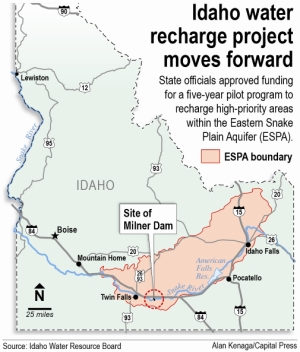forum
library
tutorial
contact

Improved Model Analyzes Aquifer Recharge
by John O'ConnellCapital Press, February 9, 2012
|
the film forum library tutorial contact |

|
Improved Model Analyzes Aquifer Rechargeby John O'ConnellCapital Press, February 9, 2012 |
Proponents want better data to run system efficiently
 A new model of the Eastern Snake Plain Aquifer capable of analyzing seasonal fluctuations in water flow should be in use by mid-July, according to the Idaho Department of Water Resources.
A new model of the Eastern Snake Plain Aquifer capable of analyzing seasonal fluctuations in water flow should be in use by mid-July, according to the Idaho Department of Water Resources.
The current model studies changes in the aquifer based on six-month intervals. The new version will utilize monthly calculations, said Rick Raymondi, bureau chief of technical services with IDWR.
The model will facilitate analysis of a $1.5 million, five-year pilot project recently approved by the Idaho Water Resource Board to identify the best locations for conducting recharge.
Idaho's recharge program pays participating canal companies $3 per acre-foot to transport water through unlined canals, where it seeps into the aquifer. The pilot project funding should cover 100,000 acre feet of recharge per year, provided there's sufficient moisture.
"It's something we can actually count on. Before it was kind of a one-shot deal. When we had a little money we did it," Gov. C.L. "Butch" Otter said.
The board intends to contract with the Idaho Water Resource Research Institute to evaluate data including how long recharge water remains in the system.
The first model was developed in 2004. At a cost of roughly $500,000 per year in labor and consultant fees, work on the new version -- also to be used for goal assessment, planning, mitigation efforts and delivery call evaluation -- started five years ago.
"There's a huge demand for the water, and we want to be as fair and accurate as we can in how we manage the water," Raymondi said.
Bill Quinn, IWRB recharge coordinator, said the state has conducted 100,000 acre-feet of recharge on average since 2009. Quinn and other staff members have made recharge recommendations in the past, but he believes working with the institute should help the board get canal companies to buy into recharge policy.
"With these changes the board is initiating, I think we're fine-tuning the program to make it as efficient and beneficial to the state as possible," Quinn said.
Roger Chase, the board's vice chairman, said members would prefer five-year contracts with canal companies to get the most complete data from each site. In addition to identifying the best recharge locations, the pilot project will prioritize where infrastructure should be built to aid in recharge, Chase said.
Lynn Tominaga, executive director of Idaho Groundwater Appropriators, hopes the state's investment will entice contributions from others with a vested interest in recharge. His organization, which supports recharge as a way to help members avert calls by surface water users, has donated to past recharge efforts.
Provided mitigation obligations are met, Tominaga said IGWA may contribute more funds to recharge in the future. Data from the pilot project should result in a more efficient program, he said.
"I think there's some question about where we've been recharging in the past. We've put a lot of water in some areas, but we really haven't seen if it's been a real benefit to the system or not," Tominaga said.
learn more on topics covered in the film
see the video
read the script
learn the songs
discussion forum
